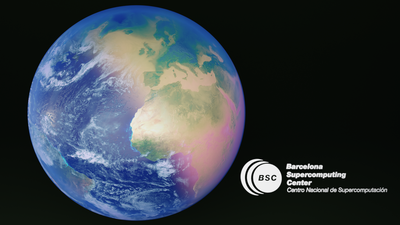The Barcelona Supercomputing Center-Centro Nacional de Supercomputación (BSC-CNS, BSC henceforth), created in 2005, has the mission to research, develop and manage information technology in order to facilitate scientific progress not only in computer science but also in a large range of applications. More than 650 people from 65 different countries perform and facilitate research into Computer Sciences, Life Sciences, Earth Sciences and Computational Applications in Science and Engineering at the BSC. The BSC is one of the eight Spanish “Severo Ochoa Centre of Excellence” institutions selected in the first round of this prestigious program in Spain, as well as one of the four hosting members of the European PRACE Research Infrastructure. The BSC hosts MareNostrum IV, a Tier-0 PRACE system with 13,7 Pflop/s capacity. In addition, the BSC hosts other High-Performance Computing (HPC) resources, among which it is worth mentioning Power9, a hybrid system with GPUs incorporated.
The Earth Sciences Department of the BSC (ES-BSC) was established with the objective of carrying out research in Earth system modelling. The ES-BSC conducts research on air quality, mineral dust and climate modelling and strongly contributes to the scientific and technological advancement in atmospheric and mineral dust modelling. In this sense, the ES-BSC develops and maintains a state-of-the-art mineral dust model: MONARCH. The excellent results of the group on this field have contributed to the recently creation of the first World Meteorological Organization (WMO) Regional Meteorological Center specialized on Atmospheric Sand and Dust Forecast, the “Barcelona Dust Forecast Center”. In which the MONARCH model has been selected as the reference mineral dust model. Currently the model provides mineral dust forecasts to the World Meteorological Organization (WMO) Sand and Dust Storm Warning Advisory and Assessment System (SDS-WAS) Northern Africa- Middle East-Europe Regional Centre that is managed by a consortium between the Spanish Weather Service (AEMET) and BSC.
ES-BSC also undertakes research on the development and assessment of dynamical and statistical methods for the prediction of global and regional climate on time scales ranging from a few weeks to several years. The EC-Earth model is used for this purpose and ES-BSC is actively implicated in the further development of the model. The formulation of the predictions includes the development and implementation of techniques to statistically downscale, calibrate and combine dynamical ensemble and empirical forecasts to satisfy specific user needs in the framework of the development of climate services.
The high performance capabilities of MareNostrum IV and the close collaboration with the Computer Sciences department allow efficiently increasing the spatial and temporal resolution of atmospheric and climate modelling systems, in order to improve our knowledge on dynamic patterns of air pollutants in complex terrains and interactions and feedbacks of physico-chemical processes occurring in the atmosphere, as well as to push the boundaries of global climate prediction.
Role in the project
BSC’s contribution to ESiWACE2 is concentrated in WP1 and WP3. In WP1, BSC will contribute to develop a “production mode” version of the EC-Earth model, computationally improving different parts of the model. BSC has been actively working with IFS, NEMO, OASIS and XIOS. ES-BSC can offer a wide range of services (based on software and hardware) to ESiWACE2 to analyse and improve performance of Earth system models. Increasing climate model efficiency requires the application of a wide set of tools to analyse and understand the behaviour of these models running in a parallel environment. BSC, through the Tools Group, develops tools like Paraver or Dimemas that can easily help the user of these codes to understand the behaviour of the code and identify possible bottlenecks and hardware related problems of the application. In WP3, ES-BSC will participate in the HPC services, delivering weather and climate benchmarks to profile earth system codes.
Names of the colleagues involved

Miguel Castrillo Mario Acosta
Relevant infrastructure and services available for climate & weather
BSC-CNS hosts MareNostrum IV, the most powerful supercomputer in Spain. The general-purpose block has 48 racks with 3,456 nodes. Each node has two Intel Xeon Platinum chips, each with 24 processors, amounting to a total of 165,888 processors and a main memory of 390 Terabytes. Its peak power is 11.15 Petaflops, or what is the same, it is able to perform more than eleven thousand trillion operations per second, ten times more than the MareNostrum III, which was installed between 2012 and 2013. Although its power is ten times greater than that of its predecessor, it only increases energy consumption by a 30% and now is of 1.3 MWatt-year.
BSC-CNS hosts CTE-POWER, a cluster based on IBM Power9 processors, with a Linux Operating System and an InfiniBand interconnection network. 54 nodes, each of them with 2 x IBM Power9 8335-GTH and 4 x GPU NVIDIA V100 (Volta). It’s mainly used to process AI computational demanding workflows.
BSC-CNS has a dedicated storage for the Earth Sciences Department of more than 3,6 PB net space that will be grown to 10 PB in the following years.
BSC-CNS is also managing a Tier-2 Earth System Grid Federation (ESGF) node.
Website
Wiki for the Earth Science department at https://earth.bsc.es/wiki/doku.php
Code repository at https://earth.bsc.es/gitlab/

